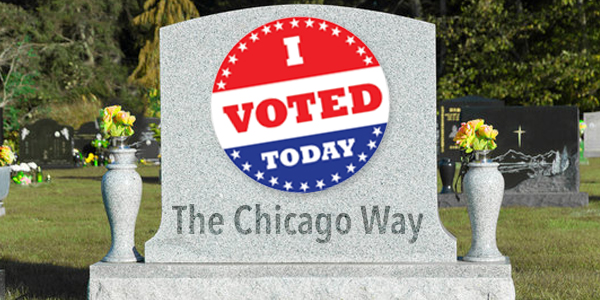
Deceased Voters Still Live on Illinois Voter Rolls
Written by Nancy Hayes
In 2020, the Public Interest Legal Foundation (PILF) wrote an article about voter rolls in America. On the heels of the Democrat’s push for vote by mail, their research revealed a large number of deceased registrants still on the voter rolls. It’s no wonder many Americans, let alone those in Illinois, don’t have much confidence in the system. After all, it would seem that if we could get rid of dead voters still on the rolls, eliminate duplicate registrants, or remove those who have moved, we would gain more confidence in the system.
The problem is the Illinois State Board of Elections. It is NOT willing to let ANYONE see their voter rolls, let alone the Public Interest Legal Foundation (PILF). So, on July 27, 2020, PILF sued the Illinois State Board of Elections, Steve Sandvoss, Executive Director of the Illinois State Board of Elections, Kyle Thomas, Director of Voting Systems and Registrations, and Cheryl Hobson, Deputy Director of Voting Systems and Registration for refusing to disclose voter registration records under the National Voter Registration Act (NVRA) of 1993. The case is still pending.
I’m certain that if the Board of Elections thought its voter registration files were even in halfway decent condition, it would in fact have shared those files. It would appear that they are likely in violation of the National Voter Registration Act of 1993 (motor voter law) which sets forth certain requirements. Section 8 of the NVRA requires states to implement procedures to maintain accurate and current voter registration lists.
In addition, Section 8 permits states to remove the name of a person from the voter registration rolls upon the request of the registrant, and, if State law so provides, for mental incapacity or for criminal conviction. The Act also requires states to conduct a general voter registration list maintenance program that makes a reasonable effort to remove ineligible persons from the voter rolls by reason of the person’s death, or a change in the residence of the registrant outside of the jurisdiction. The list maintenance program must be uniform, nondiscriminatory, and in compliance with the Voting Rights Act.
PILF used the NVRA of 1993 as grounds to sue Illinois for access to the voter files. PILF wanted the data for their study, a study which they did on “DECEASED REGISTRATIONS” across 41 states. In 2019, PILF’s study found 349,773 registrants in 41 states matched the commonly used death records.
The states with the highest number of deceased voters included: New York, Texas, Michigan, Florida, and California. These states accounted for 51 percent of the 349,773 registrants who were deceased. New York had 59,000 deceased. Texas had over 36,000. Florida had over 25,000.
I wonder where Illinois would fall among these states? After all, we are only talking about deceased registrants on the voter rolls, not those who have moved. It should not be difficult to remove dead voters from the voter rolls.
In Illinois, most funeral homes initiate the death certificate. Then it is sent to the attending physician or hospital where the death certificate is signed. The certificate gets sent back to the funeral home and additional forms are completed. From there it goes to the county health department where it is held as a record on file for a period of 4 years. From the health department, it is forwarded to the county clerk where it ends at its vital records and statistics division.
It would seem logical that the health department, the county clerk, and its vital records division could communicate when a person dies and the deceased would automatically be removed. Sounds simple. But common sense does not always play into processes when the government is involved.
Remember the PILF “Deceased Registrants” study of 2019 where 349, 773 deceased registrants in 41 states matched the death records but were NOT removed? In North Carolina, 7,933 deceased registrants were still registered to vote long after death in 2020. The Social Security Death Index revealed 95% of the registrants passed away BEFORE 2020. One deceased registrant was a WWII veteran that passed away in 1997 but remained on the voter rolls for 25 years. Another deceased registrant died in 2003, but wasn’t removed for TWO decades.
The Help America Vote Act (HAVA) of 2002 requires states to coordinate voter registration with the state agency responsible for recording deaths. That is most commonly a county’s bureau of vital statistics or the health department.
In fact, you would think the deceased voter would be removed from the rolls by the chief elected official or the information would be forwarded to county or local official who would remove the deceased voter’s name.
How many deceased registrants are on the voter files in Illinois? Is there a solution to removing deceased voters? What does the current state statute say when it comes to removing a deceased registrant or voter in Illinois?
PART II – SOME LEGISLATORS ARE WORKING ON SOLUTIONS TO REMOVE DECEASED REGISTRANTS FROM VOTER ROLLS IN ILLINOIS












